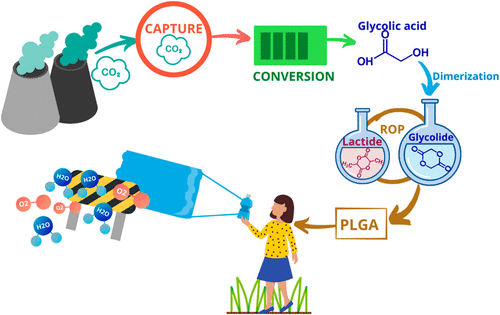当前位置:
X-MOL 学术
›
ACS Appl. Polym. Mater.
›
论文详情
Our official English website, www.x-mol.net, welcomes your feedback! (Note: you will need to create a separate account there.)
PLGA Barrier Materials from CO2. The influence of Lactide Co-monomer on Glycolic Acid Polyesters.
ACS Applied Polymer Materials ( IF 5 ) Pub Date : 2020-06-24 , DOI: 10.1021/acsapm.0c00315 Maria A Murcia Valderrama 1 , Robert-Jan van Putten 1, 2 , Gert-Jan M Gruter 1, 2
ACS Applied Polymer Materials ( IF 5 ) Pub Date : 2020-06-24 , DOI: 10.1021/acsapm.0c00315 Maria A Murcia Valderrama 1 , Robert-Jan van Putten 1, 2 , Gert-Jan M Gruter 1, 2
Affiliation

|
The combination of the predicted polymer market growth and the emergence of renewable feedstocks creates a fantastic opportunity for sustainable polymers. To replace fossil-based feedstock, there are only three alternative sustainable carbon sources: biomass, CO2, and existing plastics (via mechanical and/or chemical recycling). The ultimate circular feedstock would be CO2: it can be electrochemically reduced to formic acid derivatives that subsequently can be converted into useful monomers such as glycolic acid. This work is part of the European Horizon 2020 project “Ocean” in which the steps from CO2 to glycolic acid are developed. Polyglycolic acid (PGA) and poly(lactide-co-glycolide) (PLGA) copolyesters with high lactic acid (LA) content are well-known. PGA is very difficult to handle due to its high crystallinity. On the other hand, PLGAs with high LA content lack good oxygen and moisture barriers. The aim of this work is to understand the structure–property relationships for the mostly unexplored glycolic acid rich PLGA copolymer series and to assess their suitability as barrier materials. Thus, PLGA copolymers with between 50 and 91 mol % glycolic acid were synthesized and their properties were evaluated. Increased thermal stability was observed with increasing glycolic acid content. Only those containing 87 and 91 mol % glycolic acid were semicrystalline. A crystallization study under non-isothermal conditions revealed that copolymerization reduces the crystallization rate for PLGA compared to polylactic acid (PLA) and PGA. While PGA homopolymer crystallizes completely when cooled at 10 °C·min–1, the copolymers with 9 and 13% lactic acid show almost 10 times slower crystallization, which is a huge advantage vis-à-vis PGA for processing. The kinetics of this process, modeled with the Jeziorny-modified Avrami method, confirmed those observations. Barrier property assessment revealed great potential for these copolymers for application in barrier films. Increasing glycolic acid content in PLGA copolymers enhances the barrier to both oxygen and water vapor. At room temperature and a relative humidity below 70% the PLGA copolymers with high glycolic acid content outperform the barrier properties of polyethylene terephthalate.
中文翻译:

来自二氧化碳的PLGA阻隔材料。丙交酯共聚单体对乙醇酸聚酯的影响。
预测的聚合物市场增长与可再生原料的出现相结合,为可持续聚合物创造了绝佳的机会。为了替代基于化石的原料,只有三种替代的可持续碳源:生物质,CO 2和现有的塑料(通过机械和/或化学回收)。最终的圆形原料将是CO 2:可以通过电化学方式还原为甲酸衍生物,然后可以将其转化为有用的单体,例如乙醇酸。这项工作是“欧洲地平线2020”项目“海洋”的一部分,该项目开发了从CO 2到乙醇酸的步骤。聚乙醇酸(PGA)和聚(丙交酯-共具有高乳酸(LA)含量的β-乙交酯(PLGA)共聚酯是众所周知的。由于PGA的高结晶度,因此很难处理。另一方面,高LA含量的PLGA缺乏良好的氧气和湿气屏障。这项工作的目的是了解大多数未开发的富含乙醇酸的PLGA共聚物系列的结构与性质之间的关系,并评估其作为阻隔材料的适用性。因此,合成了具有50至91mol%乙醇酸的PLGA共聚物,并评估了它们的性能。随着乙醇酸含量的增加,观察到热稳定性增加。只有那些包含87和91mol%的乙醇酸的是半结晶的。在非等温条件下进行的结晶研究表明,与聚乳酸(PLA)和PGA相比,共聚降低了PLGA的结晶速率。当冷却至10°C·min时,PGA均聚物完全结晶–1时,乳酸含量为9%和13%的共聚物结晶速度几乎慢了10倍,这相对于PGA在加工中具有巨大优势。用Jeziorny修正的Avrami方法建模的这一过程的动力学证实了这些观察结果。阻隔性评估表明这些共聚物在阻隔膜中的应用潜力很大。PLGA共聚物中乙醇酸含量的增加会增强对氧气和水蒸气的屏障。在室温和低于70%的相对湿度下,乙醇酸含量较高的PLGA共聚物的性能优于聚对苯二甲酸乙二醇酯。
更新日期:2020-07-10
中文翻译:

来自二氧化碳的PLGA阻隔材料。丙交酯共聚单体对乙醇酸聚酯的影响。
预测的聚合物市场增长与可再生原料的出现相结合,为可持续聚合物创造了绝佳的机会。为了替代基于化石的原料,只有三种替代的可持续碳源:生物质,CO 2和现有的塑料(通过机械和/或化学回收)。最终的圆形原料将是CO 2:可以通过电化学方式还原为甲酸衍生物,然后可以将其转化为有用的单体,例如乙醇酸。这项工作是“欧洲地平线2020”项目“海洋”的一部分,该项目开发了从CO 2到乙醇酸的步骤。聚乙醇酸(PGA)和聚(丙交酯-共具有高乳酸(LA)含量的β-乙交酯(PLGA)共聚酯是众所周知的。由于PGA的高结晶度,因此很难处理。另一方面,高LA含量的PLGA缺乏良好的氧气和湿气屏障。这项工作的目的是了解大多数未开发的富含乙醇酸的PLGA共聚物系列的结构与性质之间的关系,并评估其作为阻隔材料的适用性。因此,合成了具有50至91mol%乙醇酸的PLGA共聚物,并评估了它们的性能。随着乙醇酸含量的增加,观察到热稳定性增加。只有那些包含87和91mol%的乙醇酸的是半结晶的。在非等温条件下进行的结晶研究表明,与聚乳酸(PLA)和PGA相比,共聚降低了PLGA的结晶速率。当冷却至10°C·min时,PGA均聚物完全结晶–1时,乳酸含量为9%和13%的共聚物结晶速度几乎慢了10倍,这相对于PGA在加工中具有巨大优势。用Jeziorny修正的Avrami方法建模的这一过程的动力学证实了这些观察结果。阻隔性评估表明这些共聚物在阻隔膜中的应用潜力很大。PLGA共聚物中乙醇酸含量的增加会增强对氧气和水蒸气的屏障。在室温和低于70%的相对湿度下,乙醇酸含量较高的PLGA共聚物的性能优于聚对苯二甲酸乙二醇酯。


























 京公网安备 11010802027423号
京公网安备 11010802027423号